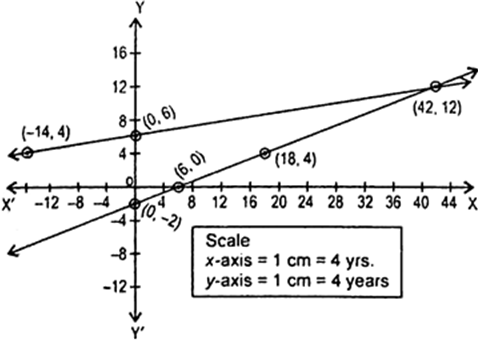Aftab tells his daughter, “Seven years ago, I was seven times as old as you were then. Also, three years from now, I shall be three times as old as you will be.” (Isn’t this interesting?) Represent this situation algebraically and graphically.
Let present age of Aftab be x years and present age of his daughter be y years.
Case I. Seven years ago,
Age of Aftab = (x - 7) years
Age of his daughter = (y - 7) years
According to question :
(x - 7) = 7 (y - 7)
⇒ x - 7 = 7y - 49
⇒ x - 7y = -42
Case II.
Three years later,
Age of Aftab = (x + 3) years
Age of his daughter = (y + 3) years
Accoring to questions,
x + 3 = 3 (y + 3)
⇒ x + 3 = 3y + 9
⇒ x — 3y = 6
So, algebraic expression be
x - 7y = -42 ...(i)
x - 3y = 6 ...(ii)
Graphical representation
For eq. (i), we have
x - 7y = -42
⇒ x — 7y — 42
Thus, we have following table :
From eqn. (ii), we have
x -3y = 6
⇒ x = 3y + 6
Thus, we have following table![]()
When we plot the graph of equations. We find that both the lines intersect at the point (42, 12). Therefore, x = 42, y = 12 is the solution of the given system of equations.
Fig. 3.1.





